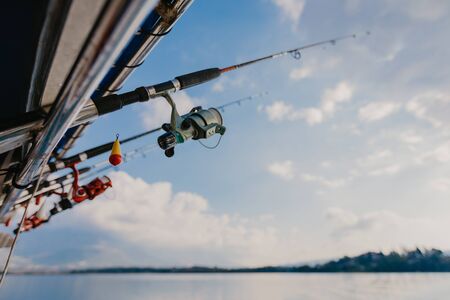Introduction to Surfcasting on UK Shores
Surfcasting along the British coastline is more than just a pastime—it’s an experience steeped in heritage, camaraderie, and a deep connection to the ever-changing sea. From the sweeping shingle of Dungeness to the rugged sands of Northumberland, anglers have long been drawn to these shores, lured by the promise of elusive cod, bass, and flounder. In recent years, surfcasting has enjoyed a surge in popularity across the UK, with both seasoned enthusiasts and newcomers eager to test their skills against the unique challenges presented by local beaches. The British coast is defined by its diversity: powerful Atlantic rollers batter the Cornish headlands, while gentler tides caress the Essex flats. These shifting conditions demand not only technical prowess but also a keen understanding of wind, tide, and weather—a blend that makes surfcasting here distinct from anywhere else. Whether you’re seeking solitude at dawn or swapping tales with fellow anglers as dusk falls over pebbled coves, surfcasting in the UK offers an unmatched blend of tradition, natural beauty, and sporting excitement.
Essential Gear for British Surfcasting
When surfcasting along the UK’s rugged coastlines, your choice of gear can make or break your session. The unpredictable British weather, fluctuating tides, and a diverse range of target species—from codling in the North Sea to bass in the southwest—mean your equipment needs to be robust and fit for purpose. Here’s a breakdown of the essentials every UK surfcaster should consider.
Surfcasting Rods
The backbone of your setup, surf rods in Britain typically range from 12 to 15 feet. Longer rods allow greater casting distance, crucial when fishing over sandbanks or beyond breaking waves. For most local conditions, opt for rods rated to cast weights between 4 and 8 ounces, giving you the flexibility to fish both light estuary marks and exposed beaches battered by Atlantic swells. Look for models with a strong, responsive blank and corrosion-resistant fittings that handle wind-driven salt spray.
Reels Built for the British Elements
Multipliers and fixed spool reels both have their place on UK shores. Fixed spools are favoured for their ease of use and reliability in rough weather, while multipliers offer superior distance once mastered. A sealed drag system is essential to keep grit and saltwater at bay during blustery sessions. Spool capacity should be generous—aim for at least 200 yards of 15–20lb mainline to cope with powerful surges and deep runs from large species.
Terminal Tackle Selection
Your end tackle needs to stand up to abrasive shingle, kelp beds, and sometimes turbulent surf. Strong hooks (size 1/0–4/0 for cod or rays; size 2–1/0 for bass or flatties), heavy-duty swivels, and impact shield leads are staples in any surf bag. Consider pulley rigs or clipped-down rigs for long-range work; these reduce tangles and improve aerodynamics in flight.
Quick Gear Reference Table
| Component | Recommended Spec | Why It Matters in the UK |
|---|---|---|
| Rod | 12–15ft, 4–8oz casting weight | Handles varied beach profiles & long casts over surf |
| Reel | Large fixed spool/multiplier, sealed drag | Tolerates sand, salt & strong tides |
| Mainline | 15–20lb mono or braid + shockleader | Withstands abrasion & heavy sea conditions |
| Hooks | Size 1/0–4/0 (cod/ray), Size 2–1/0 (bass/flounder) | Covers a range of common UK target species |
| Leads | Grip leads (4–6oz) | Keeps bait anchored in strong currents & surf |
| Tackle Extras | Pulley/clipped rigs, impact shields | Aids distance & reduces rig tangling in windy conditions |
Choosing Kit That Lasts Through British Weather
No matter how tempting it is to cut corners, investing in quality gear pays off when you’re battling sideways rain on a Yorkshire headland or braving a January night on Chesil Beach. Stainless steel components fend off corrosion, while durable rod blanks ensure you won’t be left wanting when a surprise double-figure fish hits. Take time to match your kit to your favourite marks—and always have spares on hand, as the British elements rarely play fair.
![]()
3. Mastering UK Casting Techniques
When surfcasting on British shores, understanding and perfecting your casting technique is just as crucial as choosing the right gear. The unique challenges posed by the UK’s often windswept beaches and rolling surf demand that anglers refine their approach to deliver maximum distance and accuracy. Here’s an in-depth look at the most popular casting styles among UK sea anglers, along with advice on how to adapt to the ever-changing coastal conditions.
The Pendulum Cast: Harnessing Power and Grace
The pendulum cast is a mainstay among British surfcasters seeking ultimate distance. This advanced technique involves swinging the lead weight in a wide arc, creating momentum before unleashing the rod in a fluid, circular motion. It’s a style that rewards patience and practice, offering impressive reach—perfect for targeting far-off feeding grounds beyond the breakers. British anglers favour this cast on open beaches when space allows, but it requires careful attention to safety and surroundings.
Off-the-Ground Cast: Reliable and Accessible
If you’re looking for a more approachable yet highly effective casting method, the off-the-ground cast is widely used across UK coasts. By keeping the lead weight in contact with the sand during the initial stage, this technique generates power from a solid base. It’s less demanding than the pendulum but still delivers excellent range—a favourite for mixed beaches where room may be limited or where accuracy trumps outright distance.
Overhead Thump: Quick and Versatile
The overhead thump is perhaps the most straightforward of all—simply load up your rod behind you and send your rig flying with a sharp snap forward. While it might not match the pendulum for pure distance, this cast shines when time or space is tight. It’s ideal for busy beaches or rough weather, allowing you to get a bait out efficiently when conditions are less than perfect—a common scenario along Britain’s blustery coastlines.
Adapting to Wind and Surf: The British Reality
No matter which casting style you favour, adapting to local wind direction and wave patterns is essential for success. On exposed North Sea shores or the rugged Atlantic west, crosswinds can play havoc with even the best-laid plans. Anglers often adjust by lowering their trajectory to punch through headwinds or by using heavier leads for greater control. Observing tide movements, reading subtle shifts in wind, and feeling the rhythm of incoming swells are skills honed by regulars on UK beaches—each adjustment helping secure those extra yards that can make all the difference.
Practice Makes Perfect
Ultimately, mastering these casting techniques takes time on the sand and a willingness to experiment with your approach. Whether you’re chasing cod on a winter night or bass on a summer dawn, refining your cast to suit both your target species and Britain’s famously fickle weather will set you apart as a thoughtful angler—one attuned to both tradition and nature’s cues.
Tuning Your Tackle for Maximum Distance
Chasing those extra yards in UK surfcasting isnt just about technique—its a matter of meticulous gear tuning. British beaches and regulations demand a thoughtful approach, balancing performance with environmental mindfulness. Here’s how to fine-tune your tackle for maximum casting distance while staying within legal and ecological boundaries.
Line Choice: Striking the Balance
The line is the unsung hero of distance casting. In the UK, where rocky marks and shingle beaches are common, abrasion resistance matters as much as low diameter for minimal air resistance. Braid lines offer superior casting distance, but many local anglers still favour high-quality monofilament for its forgiveness over rough ground and compliance with some match rules.
| Line Type | Pros | Cons |
|---|---|---|
| Braid | Low stretch, thin diameter, long casts | Less abrasion-resistant, may require shock leader |
| Monofilament | Abrasion-resistant, traditional feel, legal everywhere | Thicker diameter reduces distance |
Tip:
Opt for a 15–18lb mainline with a 60lb shockleader if using mono; braid users should always use a robust leader to comply with club rules and protect wildlife.
Leader Knots: Strength Meets Sensibility
A reliable leader knot is essential when you’re hauling heavy leads on remote Welsh or Cornish shores. The FG knot and Albright knot are both popular among UK casters for their slim profile and impressive strength.
| Knot Name | Best For | Difficulty Level |
|---|---|---|
| FG Knot | Braid to mono/fluoro leader connections | Advanced |
| Albright Knot | Braid or mono to heavier leader transitions | Intermediate |
| Double Uni Knot | General purpose joining of lines | Beginner-friendly |
Tip:
Smooth knots not only sail through rod guides but also reduce the risk of tangles and break-offs—a must when navigating crowded piers or conservation areas.
Reel Settings: Precision Over Power
Casting reels—especially popular multipliers used along the Kent and Norfolk coasts—need careful adjustment. Start by setting the spool tension so your sinker just begins to drop under its own weight. Next, fine-tune the braking system (magnetic or centrifugal) based on wind conditions and your casting style.
Tip:
If youre new to multipliers, err on the side of more brake until youve mastered thumbing the spool—a nasty birds nest will end any session early! Always check your drag is smooth but firm before every cast.
Sustainable Casting: Stay Legal, Stay Green
The UK’s coastal laws protect both anglers and marine life. Always use appropriately rated leaders to prevent snap-offs that leave line in the water. Dispose of old line responsibly—many UK tackle shops now offer recycling schemes. And remember: certain venues restrict lead weights or line types for environmental reasons, so check local bylaws before heading out.
Tuning Takeaway:
The devil is in the details—fine-tuning your setup not only helps you reach those distant gullies but also ensures you fish responsibly and legally on our precious British shores.
5. Top British Locations for Long-Distance Surfcasting
Britain’s coastline is a treasure trove for surfcasters seeking that perfect blend of open beaches, rolling surf, and the space to launch a long cast. Each region boasts its own celebrated venues where distance truly counts, with local character and conditions shaping every cast.
England: Shingle and Sand for the Serious Caster
Chesil Beach, Dorset: Revered among anglers, Chesil’s 18-mile stretch of shingle offers deep water within reach of a long chuck, with cod, bass, and rays on offer. Early morning or dusk sessions help avoid summer crowds—just mind the steep bank and shifting tides.
Dungeness, Kent: Famous for its unique headland and power station backdrop, Dungeness is prime ground for winter cod runs and summer bass. Here, casting distance can be the difference between blanking and bagging up—especially during spring tides.
Scotland: Rugged Beauty Meets Big Potential
Lucrative Lothian Sands: The Firth of Forth’s broad sands near Gullane and Longniddry offer excellent flatfish and bass fishing. Distance helps clear weed lines and reach deeper gutters.
Fraserburgh & Moray Firth: These northern marks provide wild surf in autumn gales; big baits and powerful casts put your gear in front of cod and coalfish beyond the breakers.
Wales: Dramatic Shores with Local Flavour
Porthcawl & Aberavon: South Wales’ sweeping beaches are classic venues for distance casting fanatics chasing whiting, rays, and smoothhound. Check tide tables closely; some access points flood quickly.
Llyn Peninsula: Remote marks like Porth Neigwl (Hell’s Mouth) combine Atlantic swells with vast sandy stretches—perfect for launching baits far into fish-rich waters.
Access Tips from Locals
Arrive early to secure parking at popular marks like Chesil or Aberavon. Many prime spots are best accessed at low tide when sandbanks are exposed—always check local signage for restrictions or seasonal closures. In Scotland, be prepared for long walks across dunes or cliffs; lightweight gear will spare your back over rugged terrain.
The Final Word on Location
No matter where you roam along Britain’s storied coastlines, success in surfcasting hinges not just on tackle and technique but on reading each beach’s unique rhythm. From England’s famous shingle to Scotland’s dramatic bays and Wales’ sweeping sands, these top venues reward those who combine thoughtful preparation with a touch of adventure.
6. Safety and Etiquette on UK Beaches
While the thrill of sending your bait out beyond the surf is at the heart of UK surfcasting, safety and respect for others must always take precedence. British beaches are shared spaces—home to fellow anglers, families, dog walkers, and wildlife. Adhering to best practices ensures everyone’s enjoyment and helps preserve these special places for future generations.
Personal Safety First
Always check tide times and weather forecasts before heading out; sudden changes in conditions can catch even experienced anglers off guard. Wear appropriate footwear for slippery rocks and shifting sands, and be mindful of strong tidal currents. When casting powerful overhead or pendulum casts, make sure the area behind you is clear—flying leads can cause serious injuries. A hi-vis jacket or hat during low light helps others spot you more easily.
Respecting Other Beach Users
Casting etiquette is essential on busy UK beaches. Give ample space to neighbouring anglers—at least 20-30 metres apart if possible—to avoid tangled lines and accidents. Politely communicate your intentions when arriving or repositioning, and never cast over someone else’s line. Outside the angling community, keep tackle boxes tidy and hooks safely stowed to prevent accidents with curious children or dogs. Remember: a friendly nod or brief chat goes a long way in upholding Britain’s renowned beachside camaraderie.
Local Bylaws and Conservation Rules
Many beaches have specific bylaws regarding fishing hours, bait collection, or protected zones; always read posted signs or consult local tackle shops if unsure. Stick to established access paths to minimise erosion of dunes and saltmarshes. Respect catch limits for species like bass or cod, returning undersized fish promptly and unharmed. Dispose of litter, discarded line, and bait packaging responsibly—nothing sours the reputation of surfcasters more than rubbish left behind.
Leave No Trace
The wild beauty of British coastlines is part of what makes surfcasting here so magical. By following good practice—staying safe, respecting others, obeying local rules—you help ensure these shores remain vibrant for all who come after you.


